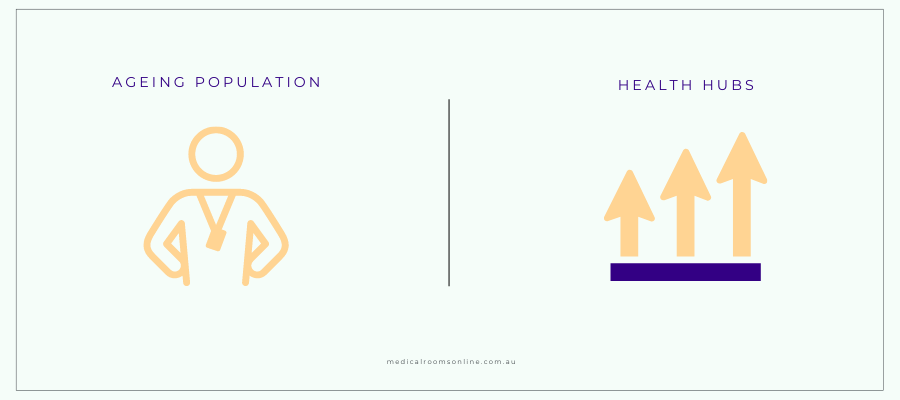Specialist healthcare property broker Bryce Stickland from Rx Property Australia explores the growing trend towards integrated healthcare delivery.
Health hubs in Australia
The integrated health hub has arrived in Australia.
Take any state or territory in the country as an example and you will quickly locate one or more of these new age healthcare facilities, whether it has just opened its doors, is under construction, or merely a blueprint for design.
What is an integrated health hub? Well, in simple terms, these ‘hubs’ are a one-stop-shop for multi-disciplinary medical and allied health care. They have been designed to bridge gaps created by disconnected medical and allied health services of old and provide today’s healthcare consumer with an array of easy to access services and greater continuity of care.
Demographics driving the movement
Australia’s ageing population is a key contributor to the ever-increasing demand for healthcare services.
People aged 65 and over are more likely to suffer from chronic health conditions, which require ongoing care and support, both in and out of hospital.
As a result, our systems and facilities are under pressure to become more efficient, easier to access in a physical sense—both in our cities, and in our regional centres—and, able to offer greater flexibility and continuity in the care they deliver.
Added spanners in the works are the fact that the number of public hospitals as a percentage of GDP is increasing, while the number of Australians committing to paying for private health insurance continues to drop.
These factors support a shift away from in-hospital, institutional-style care and towards newer, more integrated models of healthcare delivery whereby acute care is still delivered in-hospital, but the range of sub-acute and ongoing healthcare needs patients have can be met by ‘hubs’ closer to home.
Similar forces have been driving changes observed in the US market, where, over the past decade the Ambulatory Surgical Centre model has been making its mark—establishing stand-alone integrated health hubs in locations where populations are high enough to support them and they are near to public health infrastructure such as regional hospitals, or capital city Health Precincts.

Medical and allied health specialists coming together
Integrated health hubs are bringing doctors and allied health specialists together in one expansive setting, offering patients more seamless and connected healthcare experiences.
The model supports doctors moving away from generalist methods of treatment and towards greater specialisation and sub-specialisation.
Co-located with doctors providing other specialties and sub-specialities, as well as complimentary and allied health services, medical specialists can carve out a strong niche for themselves and their practices.
Hubs, therefore, present the opportunity for excellent private infrastructure development in catchment areas where historically patients would need to travel in order to access institutional centres for their sub-acute primary or secondary interventions.
Despite the forecasted turbulent economic outlook, over the next five years in Australia we can expect to see an expansion of health hub-style assets that is focused on meeting patient and community needs in the sub-acute and complimentary/support services space.
Design of hub infrastructure
Integrated health hub infrastructure represents the best in co-location design and healthcare planning.
New developments that are popping up across the country generally possess the following features:
- high-exposure, access-friendly locations
- medical class building design for optimal patient care and safety (including Class 9a (NCC) Base build specifications which allow for patients to be unconscious, stretcher/bed capable lifts, ceiling heights and dual access/exit points)
- planned allowance for abundant onsite parking, including secure tenant parking
- onsite coffee shops and catering providers.
Opportunities abound
There are a range of opportunities available for both investors and medical professionals to enter the health hub development space.
Investors may look at developing something entirely new or partner with a big name healthcare provider on a planned project that’s already in development.
Medical professionals may look to lease or buy space in a newly minted integrated health centre, connect with an investor/developer with one in the works, or even get together with a group of aligned colleagues and collectively raise equity to invest in a project themselves.
Learn more
Visit the Rx Property Australia website to learn more about integrated health hub projects we’re working on right now or contact us for a chat.
Looking to lease, buy or sell a medical property?
Find an agent who specialises in medical real estate through Medical Rooms Online



